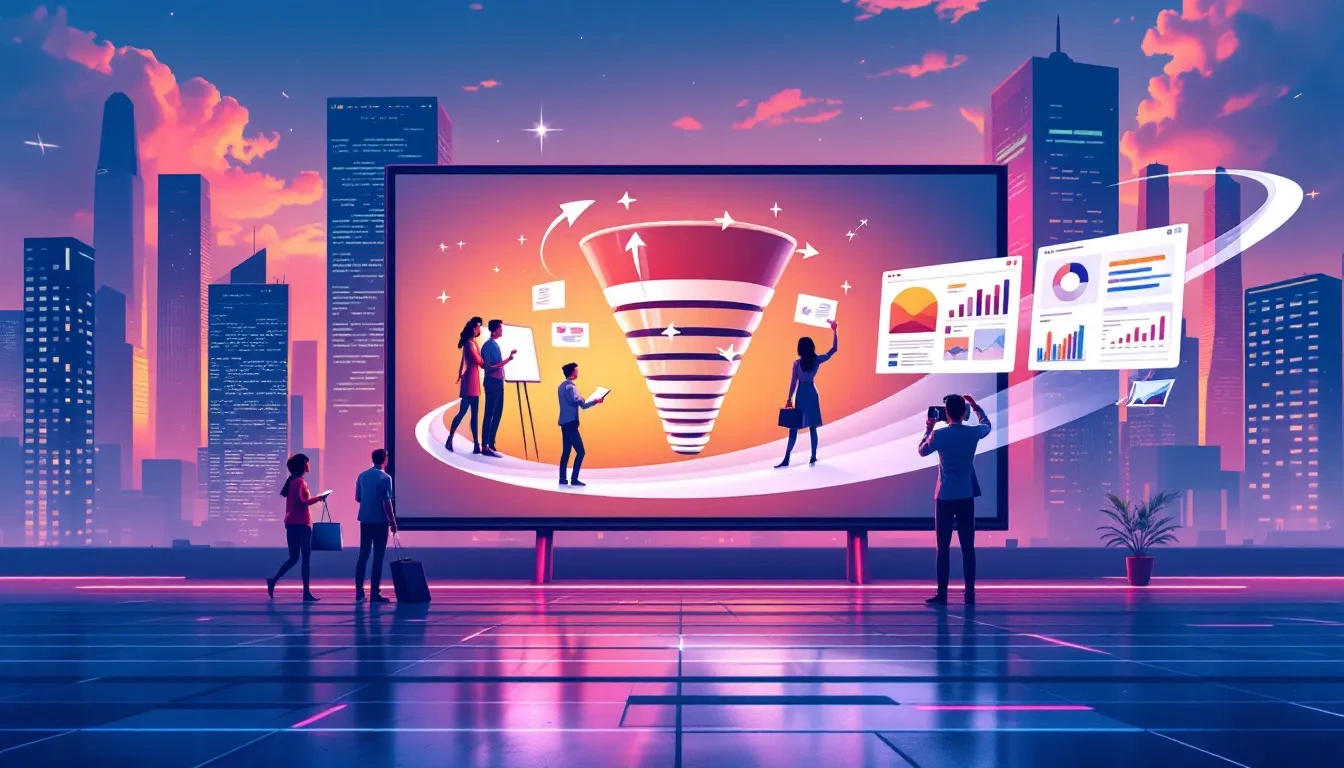Table of Contents[Hide][Show]
- Key Takeaways
- Define Your Video Marketing Goals
- Develop a Video Marketing Strategy Mission Statement
- Identify and Understand Your Target Audience
- Choose the Right Types of Videos for Your Video Strategy
- Set a Realistic Budget for Video Production
- Develop a Content Calendar
- Optimize Videos for Different Platforms
- Leverage User-Generated Content (UGC)
- Collaborate with Influencers
- Utilize Video SEO Techniques
- Measure and Analyze Performance
- Owned, Paid, and Earned Distribution Channels
- Create Social Media-Friendly Video Content
- Repurpose Video Content
- Integrate Videos in Your Sales Funnel
- Embrace AI and Automation Tools
- Summary
Ready to transform your brand’s presence with effective video marketing strategies? This guide will help you develop a robust video marketing strategy. We’ll cover everything from setting targeted goals to optimizing videos for different platforms. Get the tools you need to succeed.
Key Takeaways
- Clearly define your video marketing strategy goals to align efforts with business objectives and track success effectively.
- Understand your target audience by creating specific personas, which enhances content relevance and engagement.
- Utilize various video formats and optimize for different platforms to maximize reach, engagement, and credibility.
Define Your Video Marketing Goals

Any successful video marketing strategy starts with clear goals. Without direction, your video marketing efforts will be all over the place and ineffective.
Align your video marketing goals with your overall business goals so your video strategy supports the bigger company goals. For example, if your goal is to increase brand awareness, create branded videos showcasing your company’s mission and values.
Clear and measurable goals are key. Define what success looks like for your video marketing campaign. Are you looking for a certain number of views, engagement rates, or conversions? Having specific, measurable goals will guide your efforts and track progress.
Having a timeline for your video projects helps with deadlines and expectations. A timeline keeps everyone in sync and projects on track. This timeline is key to keeping the momentum going.
Develop a Video Marketing Strategy Mission Statement
A video marketing mission statement is crucial in creating a successful video marketing strategy. It serves as a guiding light for your video content, ensuring that every piece of content aligns with your brand’s overall goals and objectives. A well-crafted mission statement should answer the following questions:
Why are we creating video content?
Who is our target audience?
What type of content will we create?
A good mission statement should be simple, concise, and easy to remember. It should also inspire and motivate your team and encourage them to create high-quality video content that resonates with your target audience.
Example of a video marketing mission statement:
“At [Brand Name], our mission is to create engaging, informative, and entertaining video content that educates and inspires our target audience while showcasing our brand’s values and personality.”
Identify and Understand Your Target Audience
Knowing your audience is the key to any successful video marketing strategy. When you know your audience, you can tailor your content to their needs and interests and get better results.
Start by researching and defining your target audience. The more specific, the better. Create detailed personas with demographics, interests, pain points, and viewing habits. This will help you create content that resonates with your intended audience.
Talking to your audience’s problems and solving them through your videos will improve engagement. When your content is relevant and helpful to your audience, they will stay engaged and take the desired action.
Knowing your audience makes your video marketing work.
Choose the Right Types of Videos for Your Video Strategy

Choosing the right types of videos is key to your marketing strategy. Different videos serve different purposes and can help you achieve other marketing goals.
Brand videos are great for building company awareness and attracting your target audience by showing your brand’s mission. These videos help establish your brand identity and connect with viewers emotionally.
Testimonial videos are another powerful tool. They feature customers discussing their experience with your product or service, building trust and authenticity. On the other hand, customer testimonial videos use storytelling to convey complex information in a bite-sized way.
How-to videos are essential for educating audiences and building trust. Many users prefer these instructional formats to learn from brands and each other, making well-crafted how-to videos effective in engaging viewers and supporting various stages of the buyer journey.
Live videos create real-time engagement and immediacy and often result in more interaction. Expert interviews can also add credibility by sharing insights from industry leaders or internal experts and video footage.
Set a Realistic Budget for Video Production
Setting a realistic budget for video production is essential for creating high-quality video content that meets your marketing goals. A well-planned budget should take into account the following factors:
Production costs: equipment, crew, location, and talent fees
Post-production costs: editing, visual effects, and sound design
Distribution costs: hosting, advertising, and promotion
Contingency fund: unexpected expenses and changes
A realistic budget should be based on your brand’s financial resources and goals. It’s essential to prioritize your spending, allocating more funds to the most critical aspects of your video production.
Example of a video production budget breakdown:
Production costs: 40%
Post-production costs: 30%
Distribution costs: 20%
Contingency fund: 10%
Develop a Content Calendar
A content calendar is key to organizing and scheduling all your video marketing. It sets out publishing dates and project goals so everything runs smoothly. It helps you better manage and track video content ideas so your team is on the same page and deadlines are met. Add in task assignments and deadlines for clarity and accountability.
Having a specific frequency for video publishing keeps things consistent and in line with your audience’s engagement patterns. A dedicated calendar manager can update, set deadlines, and implement your strategies so everything runs smoothly and communication is streamlined.
Optimize Videos for Different Platforms

You need to optimize for different platforms to get maximum engagement and reach. Each platform has its own audience and technical requirements.
For TikTok and Instagram, short-form content is key. For YouTube, you can provide in-depth content. For Pinterest, get users to take action (read a blog or buy) with your videos. Using vertical videos will get you more reach on mobile-focused social media platforms. Adding captions makes videos more accessible, and users often watch them with sound. Optimizing for each platform will get you more engagement and relevance.
Leverage User-Generated Content (UGC)
User-generated content (UGC) is a builder of trust and credibility. It’s any content created by customers, not the brand. UGC creates a community around your brand and is perceived as more relatable and authentic than brand videos. Positive reviews and testimonials from actual customers increase brand credibility.
Brands can encourage UGC through social media contests and campaigns or by asking customers for feedback. Showcasing real customer experiences through social media marketing can build long-term relationships and turn customers into brand advocates.
UGC makes it shoppable. UGC is more effective.
Collaborate with Influencers
Working with influencers can boost your video marketing strategy efforts by using their audience and credibility. Finding the right influencer means their audience matches your target market. Micro-influencers (10,000-50,000 followers) can deliver high engagement rates.
Different collaboration types are sponsored posts, brand advocacy, and giveaways. Long-term partnerships with influencers mean a more consistent and trustworthy brand presence.
Measuring influencer marketing campaigns can be done with metrics like impressions, conversions, and engagement rates. Working with influencers increases brand awareness and engagement.
Utilize Video SEO Techniques

Video SEO helps with visibility and rankings. Titles, descriptions, and tags are key to visibility. Use keywords in those areas, and your audience will find your videos more straightforward.
Hosting on YouTube helps them rank higher. Focus on creating good content and avoid the negative impact of bad content on rankings.
Measure and Analyze Performance
Measuring and tracking are key to understanding how your video marketing strategy efforts are working. Using the right KPIs for each video will allow you to track success and areas to improve. CPL and conversion rate will show you how you’re doing.
Watch time, view-through, and engagement rates will tell you how relevant your content is to your target audience. Tracking these will help you optimize for better results.
Owned, Paid, and Earned Distribution Channels
Distribution channels are crucial in getting your video content in front of your target audience. There are three main types of distribution channels: owned, paid, and earned.
Owned distribution channels: your website, social media profiles, and email list
Paid distribution channels: advertising, sponsored content, and influencer partnerships
Earned distribution channels: word-of-mouth, reviews, and user-generated content
A successful video marketing strategy should combine all three distribution channels to maximize reach and engagement.
Example of a distribution channel strategy:
Owned: 30% of budget
Paid: 40% of budget
Earned: 30% of budget
Create Social Media-Friendly Video Content
Social media platforms are ideal for sharing video content, with billions of users consuming video content every day. To create social media-friendly video content, consider the following tips:
Keep it short and sweet: 60-second videos or less
Use eye-catching thumbnails and captions
Optimize for mobile: vertical videos and mobile-friendly formatting
Use relevant hashtags and tags
Engage with your audience: respond to comments and messages
Example of a social media video content strategy:
Create 3-5 short-form videos per week
Share on Instagram, Facebook, and Twitter
Use relevant hashtags and tags
Engage with audience: respond to comments and messages
Repurpose Video Content
Repurposing and reusing content, especially video content, means you get more out of your video marketing strategy efforts and keep your audience interested, saving time, money, and effort in creating content. Reusing videos for different channels increases engagement.
Product videos, customer testimonials, and educational content can be reused. Repeating reused content increases visibility and engagement.
Integrate Videos in Your Sales Funnel

Adding videos to your sales funnel can increase customer engagement and conversions. Top funnel videos are brand awareness, entertaining, and educating without sales pressure. Middle funnel videos provide information to help customers make a decision.
Bottom funnel videos should prompt the viewer to take action buy. Personalized video messages create a moment for the prospect to take them deeper into the buying journey.
Videos in the sales funnel can convert up to 28% of qualified leads into sales. Targeting specific stages of the buyer journey increases brand awareness and conversions.
Embrace AI and Automation Tools
AI and automation tools make the video creation process faster and more accessible. AI video tools save time so you can go from concept to final product quickly. Generative AI apps create content from text prompts, a simpler way to get visual content.
AI video editors let you make high-quality videos without technical expertise. Capsule and Peech streamline production workflows by automating design and branding, making editing easier.
AI audio tools make your videos better by removing noise and sound. Using AI and automation makes your video marketing efforts easier and more effective.
Summary
Recap the key points covered in the blog post. Emphasize the importance of each strategy and how they collectively contribute to a successful video marketing campaign.
Inspire readers to implement the strategies discussed and remind them of the potential impact of a well-executed video marketing strategy.
Frequently Asked Questions
Why is it essential to define video marketing goals?
Defining video marketing goals is crucial because it ensures every decision aligns with your business objectives, guiding your overall strategy effectively.
How can I identify and understand my target audience?
To effectively identify your target audience, research their demographics, interests, and pain points, creating detailed personas that reflect their needs.
This customized approach will allow you to connect with them more deeply and deliver relevant content that truly resonates.
What types of videos should I include in my strategy?
Integrating a mix of brand videos, customer testimonials, explainer content, live streaming events, and interviews with authorities in your field enriches the content you offer to your audience and engages them successfully.
How can I optimize my videos for different platforms?
Craft your videos to align with each platform’s specific demands and user base, ensuring you adjust aspects like format orientation to vertical when necessary and incorporate subtitles.
Adopting these tactics enhances interaction with your content and fosters a stronger bond with those who watch it!
How can AI and automation tools enhance my video marketing efforts?
AI and automation tools can significantly boost your video marketing by simplifying the production process and enabling you to create high-quality content effortlessly.
By leveraging these technologies, you can focus more on your creative vision and less on the technical details!
 Client vs Customer: Understanding Key Differences for Better Business Relationships
Client vs Customer: Understanding Key Differences for Better Business Relationships